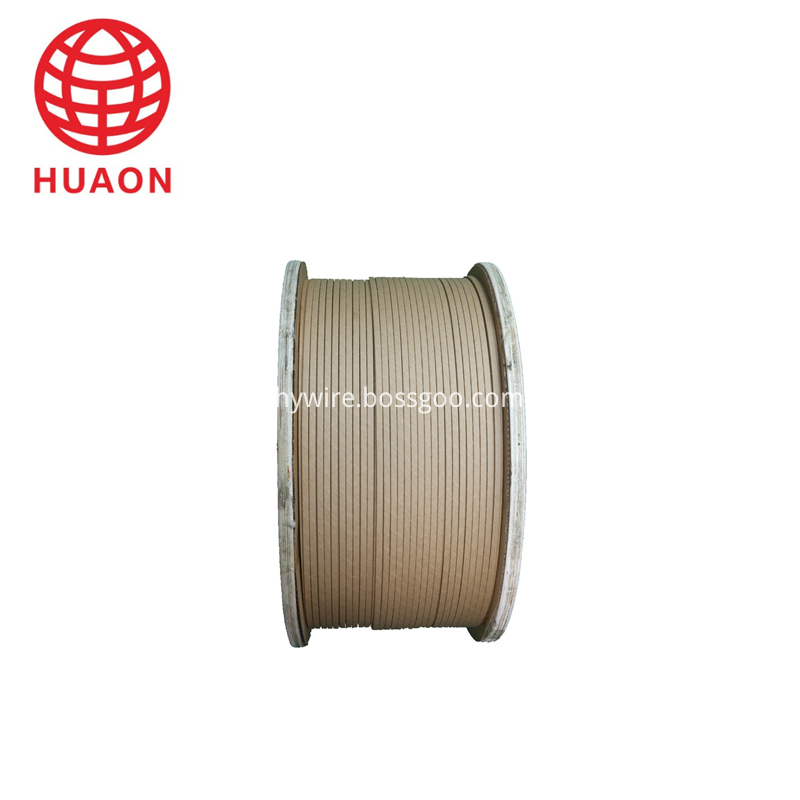Paper Covered Wire includes NOMEX Coated Copper Wire, Paper Covered Flat Aluminium Wire, Paper Covered Flat Copper Wire.
Application: oil-immersed transformer windings
Using 100% oxygen free pole as extrusion raw material,
insulation material using high density telephone paper, cable paper, polyester,
non-woven fabric.Self-locking wrapping is
adopted within 6 layers, the bending performance is 15% higher than the
national standard, the temperature index is 105℃ after the phone paper and cable paper are
impregnated, this product has excellent voltage resistance performance in oil,
widely used in transformer coil, stable performance, short processing cycle.
As per Conductor Material:Copper , aluminum
Insulation thickness:Double paper covered (DPC) or Triple Paper Covered (TPC) ,According to Customer`s requirements
Insulated Wire Copper,Paper Covered Wire,Paper Covered Copper Flat Wire,Paper Covered Insulated Wire Copper HENAN HUAYANG ELECTRICAL TECHNOLOGY GROUP CO.,LTD , https://www.huaonwire.com
About Paper Covered Wire.

As per Inner Conductor: Paper wrapped bare
The challenge of the screen fingerprint technology lies in: optical sensor technology, display driver, touch controller integration
In recent years, the release of Apple’s iPhone X sparked widespread attention and speculation when it abandoned fingerprint recognition in favor of facial recognition. This shift raised questions about the future of biometric security in smartphones. Meanwhile, Synaptics, a leading manufacturer of fingerprint chips, announced that its optical fingerprint sensors would be mass-produced in February and March of next year. Looking ahead, full-screen fingerprint technology is expected to start with specific locations on the screen and eventually evolve to allow fingerprint recognition anywhere under the glass. Over time, the three key functions—touch, display, and fingerprint recognition—are anticipated to be integrated into a single IC.
Smartphones have become essential personal assistants, playing a central role in daily life. Whether it's basic communication, financial transactions, navigation, or entertainment, we rely heavily on our devices. Most users desire an immersive experience with larger screens, but they also demand strong security, especially since phones are used for sensitive tasks. This dual expectation presents challenges for manufacturers trying to balance design and functionality.
The move toward “full-screen†designs aims to maximize the display area by removing most of the front-facing hardware. This results in a screen that stretches from edge to edge, with only narrow borders at the top and bottom. Some models even feature curved displays, enhancing user experience and enabling new applications. However, this design eliminates the physical Home button, which traditionally housed the fingerprint sensor. As fingerprint authentication remains the most popular biometric method, it must find a new place within the full-screen design.
Synaptics has been exploring off-screen fingerprint technologies, aiming to bring reliable and secure authentication to the front of the device. Currently, the only two technologies capable of penetrating up to 700 microns of cover glass are optical and ultrasonic sensing. While ultrasonic offers high sensitivity, it comes with higher power consumption and cost, limiting its use to premium devices. Optical sensing, on the other hand, has proven to be both effective and cost-efficient, with recent advancements making it suitable for integration beneath the screen.
Initially, optical sensors will be placed in designated areas, such as where the Home button once was. These can be designed as virtual buttons to maintain a familiar user experience. As the technology matures, the goal is to enable fingerprint recognition anywhere on the screen, which requires integrating optical sensors with display drivers and touch controllers. This evolution mirrors the previous integration of touch and display functions, moving from stacked to in-cell configurations.
In the long term, the three core functions—touch, display, and fingerprint recognition—could all be combined into a single IC, reducing costs and improving efficiency. This integration will not only streamline manufacturing but also enhance performance and user experience.
Facial and iris recognition are also gaining traction as complementary biometric methods. The front camera can serve multiple purposes, including unlocking the device, video calls, and biometric authentication. These technologies work alongside fingerprint recognition to provide a more robust and secure authentication system.
As users become more comfortable with biometrics, the convenience of scanning a finger instead of entering passwords becomes increasingly appealing. Full-screen fingerprint recognition offers enhanced security and a seamless user experience. It allows for larger, more detailed fingerprint images, reducing false rejections and improving accuracy. Additionally, background authentication enables smooth interactions, such as automatic unlocking or secure payments without interrupting the user’s workflow.
With the rise of multi-biometric systems like Synaptics’ MultiMatch, security can be further strengthened by combining fingerprints, facial scans, and other features. These systems are designed to detect and prevent spoofing attempts, ensuring a secure and reliable experience. Future developments may even extend to other biometric forms, such as voice or DNA recognition.
Large screens have become a key differentiator in the smartphone market, offering an immersive and engaging experience. As technology advances and production scales, even mid-range and budget devices are expected to adopt full-screen designs. Despite the shift in fingerprint placement, users still expect secure and convenient authentication on the front of their devices.
Synaptics is well-prepared for this transition, leveraging its expertise in human-machine interface technologies to deliver innovative solutions. With the right combination of hardware and software, the future of full-screen fingerprint recognition looks promising, blending style, security, and usability into one seamless experience.